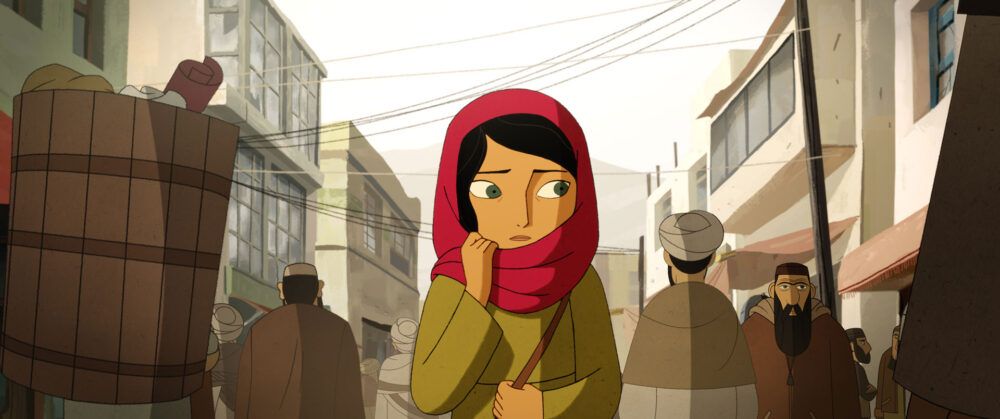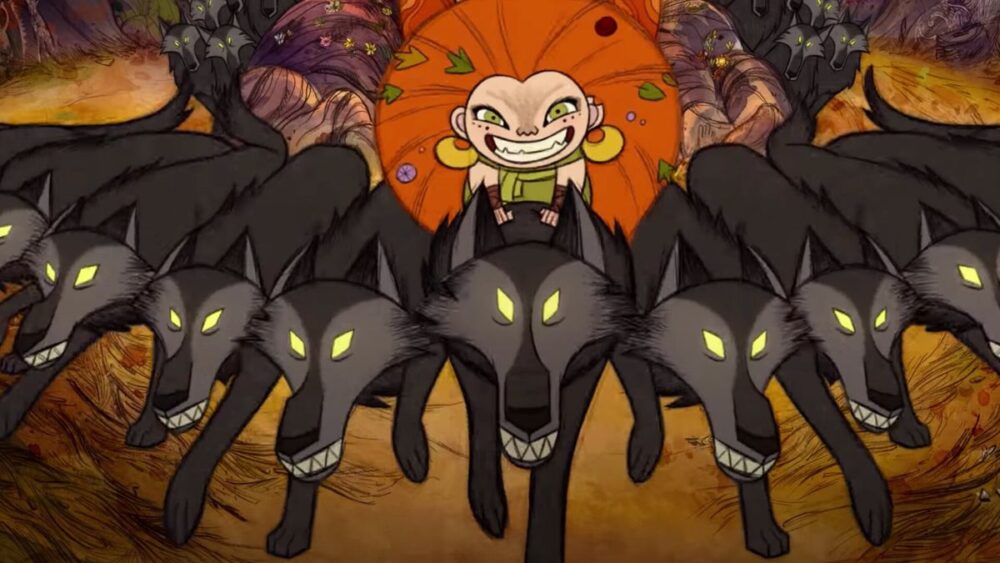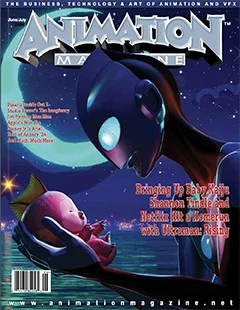|
Getting your Trinity Audio player ready...
|
In 1999, three bright-eyed, talented animation students in Ireland founded a studio. The plan was to experiment with it for a while, “then go and get real jobs.” In the decades since, Cartoon Saloon has not only kept its founders in work but propelled them to the forefront of the animation world. As the studio marks its 25th anniversary this year, the talented team behind it can look back on a body of films and series that have earned them a global following and a unique place at the crossroads between independent and big-studio production.
A quarter-century is good going in Europe’s ever-precarious animation industry. How has this globally acclaimed, much-loved Kilkenny-based studio done it? The simplistic answer: They make great films. Five features directed by founders Tomm Moore (The Secret of Kells, Song of the Sea, Wolfwalkers) and Nora Twomey (The Breadwinner, My Father’s Dragon) have earned four Oscar nominations between them, with a fifth for the short, Late Afternoon.

Inspired by Folklore
Animators have started citing the studio’s influence during industry pitches. Critics and cinephiles are paying attention: In January, BFI Southbank, London’s venerable repertory cinema, dedicated a season to the studio’s works — a rarity for animation. Their visibility is boosted by something like a house style: recognizable character designs, a distinctive approach to shape language and perspective, and storytelling rooted in folklore and environmental concerns.
But distinctiveness alone guarantees nothing. When the founders — Moore, Twomey and producer Paul Young — took to the BFI’s stage for two separate Q&As in January, there ensued fascinating discussions in which they unpicked the tangle of good fortune, operational decisions and hard work that have helped them succeed.

Cartoon Saloon was launched while the trio were at Dublin’s Ballyfermot College, enrolled in the animation course created by Sullivan Bluth during their Irish years. They set up shop in Kilkenny, a small city 80 miles from Dublin with no animation industry to speak of. This kept overhead down, and although it distanced them from potential clients, it also “meant that we were able to concentrate on our own work,” said Moore.
Early on, the founders benefited from irony. While they were setting out to make hand-drawn animation, others were sounding the death knell for the technique. The Murakami Wolf studio in Dublin was shutting down, with Jimmy Murakami “saying that 2D animation was over,” recalled Moore. So, the upstarts snapped up their desks and equipment at a low price. The studio has stuck ever since with 2D, which “doesn’t age” like CG with its ever-evolving technology, he added.

The young studio got by on odd jobs, such as illustrating schoolbooks and creating email birthday cards. One gig came from a stranger who spied Moore drawing on a bus. Meanwhile, like most European producers, they learned to operate the levers of state funding: The Irish Film Board (now known as Screen Ireland) supported their first short, Twomey’s striking but uneven From Darkness (2002), and more afterward.
“Their visibility is boosted by the presence of something like a house style: recognizable character designs, a distinctive approach to shape language and perspective, and storytelling rooted in folklore and environmental concerns.”
To finance the studio’s debut feature, The Secret of Kells (2009), which was originally conceived as a short, the team had to look abroad. They discovered the world of European co-production, which revolves around such conventions as Cartoon Movie and enables what Moore calls “independent, kind of art house animated films for families.” Buses bring them fortune: It was on one that Young met heavyweight French producer Didier Brunner (The Triplets of Belleville), who went on to board Kells as co-producer. “Our co-producers in France and Belgium … actually made people in Ireland take us more seriously,” recalled Moore.

Kells is a wonderful film and a statement of intent. It takes a hardly commercial premise — a dramatization of the creation of a Celtic illuminated manuscript from the Middle Ages — and develops it into a riot of fantasy and folklore, packaged in art direction that pays homage to the insular art of the era with its intricate patterning and flattened perspective. The film bursts with charisma. Even so, the Oscar nomination for this small-budget (roughly $8 million) 2D feature from an unknown Irish studio came as a surprise to many, not least the filmmakers themselves. The founders credit their then-new U.S. distributor, GKIDS, who were “a hundred percent behind the sensibility of the film,” as well as the grassroots support from the late artist-turned-consultant Jamie Bolio, who “was just passing out DVDs to friends.” A print of the film even made its way to Steven Spielberg.
Following the nomination, the founders spent around a year pitching their next feature, Moore’s Song of the Sea (2014), to studios, but were told it would have to be made in CGI or with songs. So, they stuck to their guns and returned to the co-production route, even settling for a smaller budget than Kells “to make it as independently as we wanted to,” said Moore. The team made a virtue of its financial constraints: When it came to the sea, a notoriously hard thing to depict in animation, they would animate individual waves then layer them up digitally, making for a particular stylized look. “You’re designing solutions to the budget restrictions, I suppose, and then the design becomes beautiful in itself.”

Yet Cartoon Saloon’s star was clearly rising, and America was growing interested. For their third feature, Twomey’s The Breadwinner (2017) — based on Deborah Ellis’ Kabul, Afghanistan-set novel of the same name — Angelina Jolie joined as executive producer, weighing in on the voice casting and matters of cultural sensitivity. Wolfwalkers (2020), which concluded Moore’s “Irish folklore trilogy,” was acquired by Apple, and My Father’s Dragon (2022) by Netflix — with nary a request to change their whole approach. By then, the studio’s style was precisely what was wanted. On Dragon, as the team faced the hazards of lockdowns, “money was the one thing we did have,” reflected Twomey.
Throughout, Cartoon Saloon has aimed to keep crew busy between major productions — no mean feat for a medium-sized European studio — without overstretching itself. “The sweet spot [is] if you have three things in production [at once],” said Young, who added that a workforce of 150-200 suits them best. Projects over the years have included work on Roger Allers’ The Prophet (2014) and Mamoru Hosoda’s Belle (2021), as well as the studio’s own preschool series, Puffin Rock (2015-16), which yielded a spinoff feature in 2023. And in 2017, they partnered with Canada’s Mercury Filmworks to launch a new studio, Lighthouse, in Kilkenny, to broaden the opportunities available to the city’s growing animation community.

Principled Principals
Commercials have played their part in keeping Cartoon Saloon afloat, but mostly in its early years: The Golden Age of advertising was “fading” as the studio got going, according to Moore. And the founders’ environmental views expressed themselves as clearly through their strategic decisions as through the stories they told. They once turned down a McDonald’s commercial “when we were barely paying the bills,” since it clashed with Moore’s veganism. On the flip side, they jumped at the chance to make a spot for Greenpeace that warned of deforestation linked to meat production.
Then there are the shorts. Like great studios from Aardman to Pixar, Cartoon Saloon uses these as an incubator of ideas, techniques and talent: Only three of the eight are co-directed by Moore or Twomey. Many are memorable films in their own right, taking wholly different narrative or graphic approaches from the features, such as the oppressive fairy-tale atmospherics of Adrien Merigeau’s Old Fangs (2009) or the gliding abstractions of Late Afternoon (2017), whose director Louise Bagnall is now working on the feature Julián (see sidebar) at the studio. As I watched a sold-out program of the shorts at the BFI, it occurred to me that they amounted to a potted history of the company, tracing their trajectory from a scrappy startup reliant on public funding to a global brand working with Disney (on the Star Wars: Visions episode, Screecher’s Reach [2023] — Young’s directorial debut, which received an Emmy and Annie Award). Taking to the stage afterward, the founders were visibly moved.

There is a quality shared by all three, in their manners of speaking as well as their storytelling: sincerity. This distinguishes them in an age saturated with irony. I suspect it also underpins a sense of purpose — of clarity about what they want to do with their company — which has helped see them through. Always comfortable with natural imagery, Moore noted the difficulty of running a studio when the market and audiences are forever changing: “It’s like a shark; you have to keep swimming. You never reach the [point where you think], ‘Now we can relax.’” Then he added, “I feel we’ve been really lucky by being persistent with the stuff we cared about and believed in.”
Learn more about the studio at cartoonsaloon.ie.
Alex Dudok de Wit is an animation journalist, consultant and festival programmer. He is the author of the BFI Film Classics book on Grave of the Fireflies and translator of Hayao Miyazaki’s manga Shuna’s Journey.
A Brave New Tale
Last year, audiences at the co-pro pitch event Cartoon Movie in France were lucky to get an early look at Cartoon Saloon’s next big animated movie, Julián. Based on Jessica Love’s acclaimed picture book, Julián Is a Mermaid, the film centers on a Dominican American boy who dreams of participating in the Coney Island Mermaid Parade and his relationship with his loving abuela. The film is directed by Louise Bagnall, who directed the Oscar-nominated short Late Afternoon, and produced by studio principal Paul Young. Exploring the nuances of gender fluidity and the immigrant experience in modern-day Brooklyn, the movie is the kind of sensitive, well-observed project that has become the studio’s specialty over the years.

A Cartoon Saloon Filmography
Features
2009 The Secret of Kells
2014 The Prophet (On Love)
Song of the Sea
2017 The Breadwinner
2020 Wolfwalkers
2022 My Father’s Dragon
2023 Puffin Rock and the New Friends
2025 Julián
Series
2007 Skunk Fu!
2009 Anam an Amhráin
2015 Puffin Rock
2018 Cúl an Tí
2020 Dorg Van Dango
2022 Vikingskool
Shorts
2002 From Darkness
2004 Cúilín Dualach
2009 Old Fangs
2014 Somewhere Down the Line
2018 The Ledge End of Phil: From Accounting
2017 Late Afternoon
2020 There’s a Monster in My Kitchen
2023 Star Wars: Visions “Screecher’s Reach”







 Win a Funko X Lilo & Stitch Prize Pack!
Win a Funko X Lilo & Stitch Prize Pack! 
